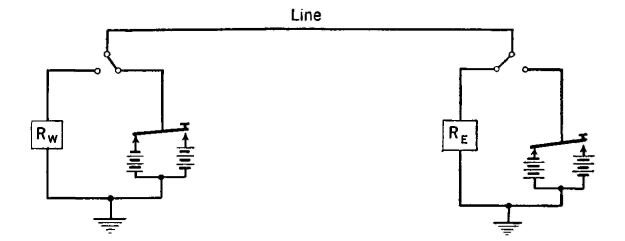| Electrical Communication is a free textbook on the basics of communication technology. See the editorial for more information.... |

|

Home  Telegraph Systems Telegraph Systems  Polar Direct-Current Telegraph Systems Polar Direct-Current Telegraph Systems |
|||||||






|
|||||||
Polar Direct-Current Telegraph SystemsIn a polar, or double-current, system2 the signal impulses are as shown in Fig. 6 if the capacitive and inductive effects are neglected. A dot or a dash is caused by current in one direction, whereas a space is produced by current flow in the opposite direction. This accounts for the term "double-current."
The use of double current requires a relay which is polarized,2 that is, which will operate in only one direction for current flow in a specified direction. A relay may be polarized by using a permanent magnet, or by the use of an auxiliary direct-current winding which produces a polarizing magnetic flux. A diagram of a magnetically polarized relay is shown in Fig. 7.
The polarized, or polar, relay consists of yokes of good magnetic flux-conducting material, such as Permalloy, and one or more operating windings that are connected to the line. A permanent magnet provides the polarizing effect. As indicated in Fig. 7, an armature (also of good flux-conducting material) operating in the air gap carries the contacts for closing the sounder circuit. When a current in one direction (for instance, corresponding to a space) flows through the circuit, the steady magnetic flux provided by the permanent magnet will be decreased in one yoke and the flux in the other yoke will be strengthened. The armature will then be drawn to the spacing position. When current in the other direction flows, the action is reversed and the armature moves to the marking position, closing the sounder circuit and causing an audible sound corresponding to the signal being sent. A simplified polar, or double-current, system giving single operation2 or simplex operation (that is, transmission in only one direction at a time) is shown in Fig. 8. With the switches as indicated, transmission is from the west (left) to the east station. The relays RW and RE are polarized relays actuating the connected sounders for current in one direction only.
|
|||||||
Home  Telegraph Systems Telegraph Systems  Polar Direct-Current Telegraph Systems Polar Direct-Current Telegraph Systems |
|||||||
Last Update: 2011-05-30




